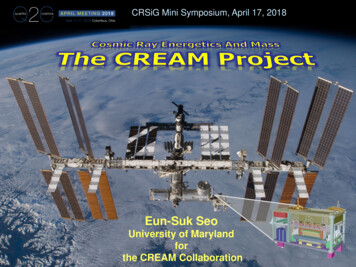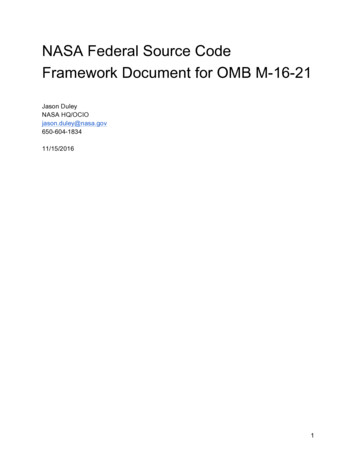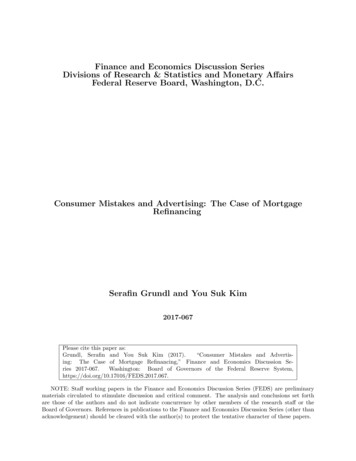
Transcription
CRSiG Mini Symposium, April 17, 2018Eun-Suk SeoUniversity of Marylandforthe CREAM Collaboration
CREAM CollaborationE. S. Seoa,b,*, Y. Amarea, T. Andersonc, D. Angelaszeka,b, N. Anthonya, G. H. Choid, M. Chunga, M.Copleya, S. Coutuc, L. Deromee, L. Eraude, C. Falanaa, A. Gerretya, L. Hagenaua, J. H. Hana, H. G.Huha, Y. S. Hwangf, H. J. Hyunf, S. Imc, H.B. Jeonf, J. A. Jeond, I. S. Jeongd, S. C. Kang,f H. J. Kimf,K. C. Kima, M. H. Kima, H. Y. Leed, J. Leed, M. H. Leea, C. Lamba, J. Lianga, J. T. Linkg, L. Lua, L.Lutza, B. Marka, A. Menchaca-Rochah, T. Mernika, J. W. Mitchellg, M. Mishnera, S. I. Mognetc , S.Mortona, M. Nestera, S. Nutteri, O. Ofohaa, H. Parkf, I. H. Parkd, J. M. Parkf, N. Picot-Clementea,S. Rostskya, J. R. Smitha, T. Tatolia, P. Walpolea, R. P. Weinmanna, J. Wua, and Y. S. Yoona,baInst.for Phys. Sci. and Tech., University of Maryland, College Park, MD, USAof Physics, University of Maryland, College Park, MD, USAcDept. of Physics, Penn State University, University Park, PA, USAdDept. of Physics, Sungkyunkwan University, Republic of KoreaeLaboratoire de Physique Subatomique et de Cosmologie, Grenoble, FrancefDept. of Physics, Kyungpook National University, Republic of KoreagAstroparticle Physics Laboratory, NASA Goddard Space Flight Center, USAhInstituto de Fisica, Universidad Nacional Autonoma de Mexico, MexicoiDept. of Physics and Geology, Northern Kentucky University, USA* Principal InvestigatorThanks to NASA HQ/GSFC WFF/JSC/MSFC/KSC, SpaceX and JAXACREAMbDept.Eun-Suk Seo2
On the News: ISS-CREAM launch on SpaceX-12, 8/14/17CREAMEun-Suk Seo3
CREAMCosmic Ray Energetics And MassSeo et al. Adv. in Space Res., 33 (10), 1777, 2004; Ahn et al., NIM A, 579, 1034, 2007 Transition Radiation Detector (TRD)and Tungsten Scintillating FiberCalorimeter- In-flight cross-calibration ofenergy scalesCREAM Complementary ChargeMeasurements- Timing-Based Charge Detector- Cherenkov Counter- Pixelated Silicon Charge DetectorEun-Suk Seo4
CREAM Balloon Flight HeritageSeven Balloon Flights in Antarctica: 191 days Cumulative ExposureCREAM-I12/16/04 – 1/27/0542 daysCREAM-IV12/19/08 – 1/7/0919 days 13 hrsCREAMCREAM-II12/16/05-1/13/0628 daysCREAM-V12/1/09 – 1/8/1037 days 10 hrsCREAM-III12/19/07-1/17/0829 daysCREAM-VI12/21/10 – 12/26/105 days 16 hrsEun-Suk SeoBACCUS11/28/16-12/28/1630 days 2 hrs5
BACCUS Balloon Payload 30 Days FlightKim et al. Proc. 35th ICRC, Busan, 182, 2017 Boron And Carbon Cosmic rays in the Upper Stratosphere(BACCUS) set two records: the earliest launch, i.e., the first LDBto launch in November and (2) the closest landing to the launchsite. BACCUS is to investigate cosmic ray propagation history usingBoron to Carbon ratio at high energies where measurements arenot available.BACCUS flight trajectoryNov. 28 – Dec. 28, 2016 The BACCUS experiment provides simultaneous measurementsof cosmic-ray nuclei from Z 1 to Z 26 using segmented siliconcharge detector and timing charge detector. Both calorimeter andtransition radiation detector provide energy measurements.BACCUS was recovered with 1 TwinOtter and 1 Helicopter flight afterlanding on the Ross Ice Shelf only 55nautical miles east of McMurdo Station.CREAMBACCUS payload at CSBFduring the end to end test.Eun-Suk Seo66PI Eun-Suk Seo, University of Maryland
How do cosmic accelerators work?BESSSuper TiGERATIC&CREAMElemental ChargeAMSMission GoalExtend the energy reach of directmeasurements of cosmic rays to thehighest energy possible to investigatecosmic ray origins, acceleration andpropagation.CREAMground based IndirectmeasurementsEun-Suk Seo7
Is the “knee” due to a limit in SNR acceleration? The all particle spectrum extendsseveral orders of magnitude beyondthe highest energies thoughtpossible for supernova shocks And, there is a “knee” (indexchange) above 1015 eV Acceleration limit signature:Characteristic elementalcomposition change over twodecades in energy below andapproaching the knee Direct measurements of individualelemental spectra can test thesupernova acceleration modelKneeAnkleSNR acceleration limit:EmaxCREAMEun-Suk Seov ZeBVT Ζ Emax pc8
Elemental Spectra over 4 decades in energyYoon et al. ApJ 728, 122, 2011; Ahn et al., ApJ 715, 1400, 2010; Ahn et al. ApJ 707, 593, 2009Excellent charge resolution from SCDDistribution of cosmic-ray chargemeasured with the SCD. Theindividual elements are clearlyidentified with excellent chargeresolution. The relative abundance inthis plot has no physical significance.CREAMEun-Suk Seo9
CREAM spectra harder than prior lower energy measurementsYoon et al. ApJ 728, 122, 2011; Ahn et al. ApJ 714, L89, 2010PAMELA (Adriani et al., Science 332, 69, 2011)AMS-02 (Choutko et al., #1262; Haino et al.γCREAM 2.58 0.02#1265, ICRC, Rio de Janeiro, 2013)HeγAMS-01 2.74 0.01CREAM-IγP 2.66 0.02γHe 2.58 0.02(Ahn et al., ApJ 714, L89, 2010)CREAM C-Feγ 200 GeV/n 2.77 0.03γ 200 GeV/n 2.56 0.04CREAMIt provides important constraints on cosmicray acceleration and propagation models,and it must be accounted for inexplanations of the e e- anomaly andcosmic ray “knee.”Eun-Suk Seo10
Spectral Hardening ConfirmedAguilar et al., PRL 113, 121102, 2014Aguilar et al., PRL 114, 171103 & 115, 211101, 2015Aguilar et al. PRL 119, 251101, 2017Accardo et al., PRL 113, 121101, 2014Aguilar et al., PRL 113, 121102, 2014Aguilar et al., PRL 114, 171103, 2015CREAMEun-Suk Seo11
Need to extend measurements to higher energiesPtuskin et al. ApJ 718, 31, 2010Ptuskin et al. ApJ 763, 47, 2013Zatsepin & Sokolskaya, A&A, 458,1, 2006CREAMEun-Suk Seo12
ISS-CREAM: CREAM for the ISSE. S. Seo et al, Advances in Space Research, 53/10, 1451, 2014SpaceX-12 Launch on 8/14/2017ISS-CREAM installed on the ISS 8/22/17JEM-EF #2Mass: 1258 kgPower: 415 WData rate: 500 kbps Building on the success of the balloon flights, the payload has been transformed foraccommodation on the ISS (NASA’s share of JEM-EF). Increase the exposure by an order of magnitude ISS-CREAM will measure cosmic ray energy spectra from 1012 to 1015 eV withindividual element precision over the range from protons to iron to:- Probe cosmic ray origin, acceleration and propagation.- Search for spectral features from nearby/young sources, acceleration effects,or propagation history.CREAMEun-Suk Seo13
ISS-CREAMHurricane HarveyCREAMEun-Suk Seo14
ISS-CREAM InstrumentSeo et al. Adv. in Space Res., 53/10, 1451, 2014; Smith et al. PoS(ICRC2017)199, 2017Silicon Charge Detector (SCD) Lee et al. PoS(ICRC2017)244, 2017; Hong et al. PoS(ICRC2017)229, 2017.Precise charge measurements with charge resolution of 0.2e. 4 layers of 79 cm x 79 cm active area (2.12 cm2 pixels).Top/Bottom CountingDetector (T/BCD) Kang et al.Boronated ScintillatorDetector (BSD) Link et al.PoS(ICRC2015)611, 2015. Additional e/p separation bydetection of thermal neutrons.CREAMCalorimeter (CAL) Picot-Clementeet al. PoS(ICRC2017)247, 2017. 20 layers of alternating tungstenplates and scintillating fibers. Determines energy. Provides tracking and trigger.Eun-Suk SeoPoS(ICRC2017)250, 2017;Hwang et al. JINT10 (07),P07018, 2015. Plastic scintillator instrumentedwith an array of 20 x 20photodiodes for e/p separation. Independent trigger.15
CREAM Science OperationMarshall SpaceFlight CenterHuntsville OperationSupport Center (HOSC)EthernetHOSC Near Real Data flowTime (NRT) DataCommandsScience Operation Center, UMDPlayback DataMonitoringSTELLA& TReKSTELLA& TReKData relayOPTIMISOperation logEHSWebIVoDSCREAMEvent DisplayData MergingData MonitoringEun-Suk SeoReceiving dataSendingcommands16
Web Monitoring and Data a –– Noise level of one layer of SCDMonitor performance of CREAMinstrument using in-flight calibration dataHPD aliveness of CALEvery hour: Noise level (pedestal runs) ofCalorimeter, SCD, and TCD/BCDEvery two hours: Charge gain, HPDaliveness etc.Relay the housekeeping data to a webserver for worldwide monitoring–1558 housekeeping parameters every 5sec–Provides warning by color display whenvalues are out of range. Visualize interactions of cosmic rays inCREAM by generating event displayplots of science events. Process all data and distribute them inROOT format for analysis.–CREAMRefine the initial pre-launch detectorcalibrations channel by channel to reflectthe actual flight conditions, including timedependent effectsEun-Suk Seo17
Currently taking data only during non-SAA orbitTo avoid radiation damage to the instrumentSouth Atlantic AnomalyCREAMEun-Suk Seo18
CAL pedestal reached a plateau in November 2017CREAMEun-Suk Seo19
Cosmic Ray DetectionCREAMEun-Suk Seo20
CAL on-orbit performanceCosmic ray all particle countsPreliminaryCREAMEun-Suk Seo21
SCD on-orbit performancelayer1layer2layer3layer4CREAMEun-Suk Seo22
ISS-CREAM takes the next major stepIncreases the exposure by an order of magnitude! The ISS-CREAM spacemission can take the nextmajor step to 1015 eV, andbeyond, limited only bystatistics. The 3-year goal, 1-yearminimum exposure wouldgreatly reduce the statisticaluncertainties and extendCREAM measurements toenergies beyond any reachpossible with balloon flights.CREAM ISS-CREAMSeo et al. ASR 53/10, 1451, 2014Eun-Suk Seo23
CREAMEun-Suk Seo24
Thank you!http://cosmicray.umd.eduCREAMEun-Suk Seo25
Nov. 28 - Dec. 28, 2016. 6 Boron And Carbon Cosmic rays in the Upper Stratosphere (BACCUS) set two records: the earliest launch, i.e., the first LDB to launch in November and (2) the closest landing to the launch site. BACCUS is to investigate cosmic ray propagation history using Boron to Carbon ratio at high energies where .










